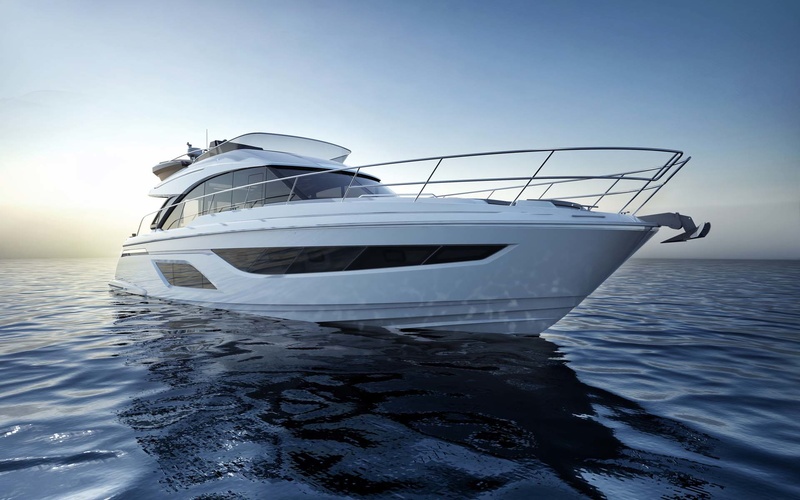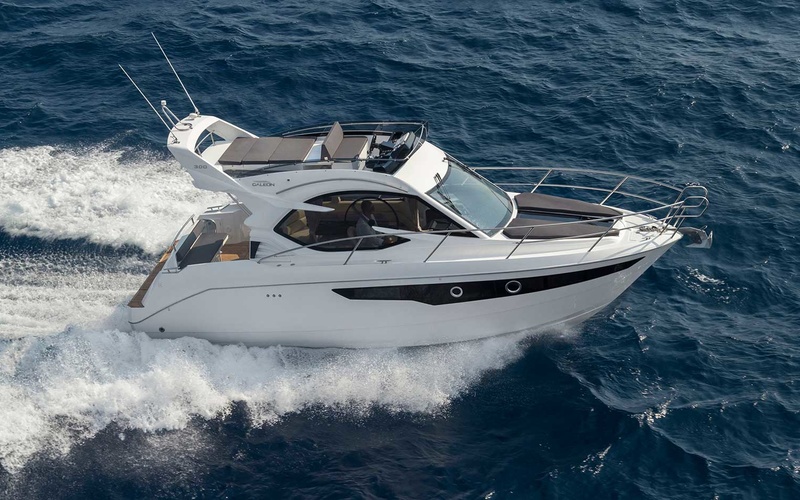
Flybridge Yachts
The ultimate recreational motoryachts designed for pleasure cruising featuring an open bridge deck with commanding views and plenty of entertaining space.Manufacturers of flybridge Yachts




The brand Absolute Yachts produces expedition yachts and trawlers and semi-displacement yachts. There are 14 models currently in production ranging from 14 to 23 meters. The current model range includes 3 lines: Coupé, Flybridge and Navetta. We invite you to explore all current and older models from Absolute Yachts and contact us for sales and pricing information.
Read more >




The brand Azimut Yachts produces flybridge yachts, semi-displacement yachts and is also active in the superyacht market. There are 35 models currently in production ranging from 10 to 39 meters. The current model range includes 7 lines: Atlantis, Fly, Grande, Magellano, S, Seadeck and Verve. We invite you to explore all current and older models from Azimut Yachts and contact us for sales and pricing information.
Read more >




The brand Bavaria Yachts produces aft cockpit sailboats and semi-enclosed yachts. There are 27 models currently in production ranging from 9 to 18 meters. The current model range includes 8 lines: C-Line, Cruiser Line, R-Line, S-Line, SR-Line, Vida Line, Virtess Line and Vision Line. We invite you to explore all current and older models from Bavaria Yachts and contact us for sales and pricing information.
Read more >


The brand Beneteau Yachts produces aft cockpit sailboats and outboard boats. There are 44 models currently in production ranging from 4 to 19 meters. The current model range includes 8 lines: Antares, First, First SE, Flyer, Gran Turismo, Oceanis, Oceanis yacht and Swift Trawler. We invite you to explore all current and older models from Beneteau Yachts and contact us for sales and pricing information.
Read more >


The brand Burger Boat produces aluminum yachts, motor superyachts and is also active in the superyacht market. There are 11 models currently in production ranging from 15 to 66 meters. We invite you to explore all current and older models from Burger Boat and contact us for sales and pricing information.
Read more >




The brand CL Yachts produces expedition yachts and trawlers, flybridge yachts and is also active in the superyacht market. There are 5 models currently in production ranging from 19 to 30 meters. The current model range includes 3 lines: A, B and X. We invite you to explore all current and older models from CL Yachts and contact us for sales and pricing information.
Read more >


The brand Canados produces motor superyachts, semi-displacement yachts and is also active in the superyacht market. There are 20 models currently in production ranging from 13 to 44 meters. The current model range includes 3 lines: Canados, Gladiator and Oceanic. We invite you to explore all current and older models from Canados and contact us for sales and pricing information.
Read more >


The brand Contest Yachts produces aft cockpit sailboats, luxury sailing yachts and is also active in the superyacht market. There are 14 models currently in production ranging from 12 to 26 meters. The current model range includes 2 lines: Motor and Sailing. We invite you to explore all current and older models from Contest Yachts and contact us for sales and pricing information.
Read more >


The brand Dynamiq Yachts produces aluminum yachts, motor superyachts and is also active in the superyacht market. There are 11 models currently in production ranging from 27 to 52 meters. The current model range includes 3 lines: GTM, GTT and Global. We invite you to explore all current and older models from Dynamiq Yachts and contact us for sales and pricing information.
Read more >




The brand Fairline Yachts produces flybridge yachts, semi-enclosed yachts and is also active in the superyacht market. There are 11 models currently in production ranging from 9 to 21 meters. The current model range includes 4 lines: F-Line, Phantom, Squadron and Targa. We invite you to explore all current and older models from Fairline Yachts and contact us for sales and pricing information.
Read more >




The brand Ferretti Yachts produces flybridge yachts, semi-displacement yachts and is also active in the superyacht market. There are 10 models currently in production ranging from 15 to 31 meters. The current model range includes 2 lines: Flybridge and Infynito. We invite you to explore all current and older models from Ferretti Yachts and contact us for sales and pricing information.
Read more >




The brand Galeon Yachts produces flybridge yachts, semi-enclosed yachts and is also active in the superyacht market. There are 28 models currently in production ranging from 9 to 26 meters. The current model range includes 5 lines: Flybridge, GTO, Hardtop, Skydeck and Sport Cruiser. We invite you to explore all current and older models from Galeon Yachts and contact us for sales and pricing information.
Read more >
Selling Brokers Flybridge Yachts
Category Description
A must in the warm waters of the Mediterranean, the Caribbean or the Persian Gulf, a flybridge yacht features a spacious bridge deck, which is the most prominent element of the vessel. The bridge deck is an open outdoor living space that is situated on the uppermost level of the yacht. It offers panoramic views of the surrounding waterways and provides ample space for lounging, dining, and entertaining.. Depending on the boat’s size, its amenities may include sun decks, jacuzzis, wet bars, dining areas, swim platforms, a tender garage and even swimming pools and helipads.
There is a wide range of flybridge offerings with almost every boat brand focusing on 50-70-foot cruisers with fast and effective planing hulls. In this size range, flybridge yachts are literally floating mansions designed for leisurely cruising and comfortable living on the water. These yachts typically include spacious salons featuring large windows that allow plenty of natural light to flood in. The salon is equipped with comfortable seating, a dining table and entertainment systems, making it the perfect place to relax and unwind after a day on the water.
The galley is another important element of a flybridge yacht. The galley is the yacht's kitchen, and it is typically located below deck. The galley is designed to be both functional and stylish, with high-end appliances, ample storage space, and beautiful finishes. Many flybridge yachts also feature a dining area adjacent to the galley, creating a comfortable and convenient space for meals.
The staterooms are the sleeping quarters on a flybridge yacht. These are typically located below deck and can accommodate many guests depending on the yacht's total size. The staterooms are designed to be luxurious and comfortable, with plush bedding, plenty of storage space, and private en-suite bathrooms. Many flybridge yachts also feature a master suite, which is a larger and more luxurious stateroom that is typically located at the rear of the yacht and of course is reserved for the boat's master.
itBoat invites you to explore all the best flybridge yacht models in the market today in our extensive catalogue and browse from the hundreds of new and used yachts available in our marketplace.
How are flybridge yachts built?
Most flybridge boats have hulls built from glass-reinforced plastic (GRP). A plastic mold is lined with gelcoat and layers of fiberglass cloth, which are then impregnated with resin using a method called Vacuum Infusion Process. When the resin dries out, the hull is taken out of the mold. The superstructure, including the cabin and flybridge, is manufactured separately, to be joined with the hull later on.
In earlier years, fiberglass was literally made of fibers of glass, but now modern boatyards use various kinds of plastic fibers, carbon fiber being one of the most popular choices. So today, FRP (fiber reinforced plastic) is the more accurate term for the material. FRP is an inexpensive and undemanding material, not prone to rusting like steel or rotting, like wood. Fiberglass boats are easy to maintain as they need no anodes, no sun protection, and are easy to clean. Nevertheless, you still have to apply antifouling and, on average, buff and wax the gel coat twice a season to keep the hull shine longer.
Fiberglass is stronger than wood, but steel hulls are stronger than plastic ones (and a lot heavier). The main drawback of fiberglass hulls is that if you hit an underwater object hard, a plastic hull will crack, whereas steel, in most cases, will just bend in.
What types of engines are used on flybridge boats?
Most flybridge boats are powered by inboard diesel engines, with two of the most popular types of drivetrain – the traditional shaft or the pod drive.
Pod drives have a number of advantages. Firstly, they are more compact than shaft drives, so the engine compartment can be made smaller, freeing up room to expand the living spaces onboard. Additionally, pod drives usually come with joystick controls for easy handling of the boat, allowing you to make 360-degree turns without any effort. The Volvo Penta IPS pod drive is the solution of choice on the market today. Classic shaft drives still have a lot of fans however, they are traditionally considered more reliable and easier to maintain and repair.
Similar categories














































































 256
256
 230
230
 660
660
 629
629
 468
468
